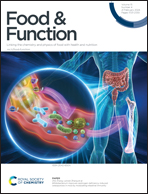Formation of EGCG oxidation self-assembled nanoparticles and their antioxidant activity in vitro and hepatic REDOX regulation activity in vivo†
Abstract
(-)-Epigallocatechin-3-gallate (EGCG) is a major polyphenol in tea and exerts several health-promoting effects. It easily autoxidizes into complex polymers and becomes deactivated due to the presence of multiple phenolic hydroxyl structures. Nonetheless, the morphology and biological activity of complex EGCG polymers are yet to be clarified. The present study demonstrated that EGCG autoxidation self-assembled nanoparticles (ENPs) exhibit antioxidant activity in vitro and hepatic REDOX homeostasis regulation activity in vivo. Also, the formation of ENPs during the EGCG autoxidation process was based on the intermolecular interaction forces that maintain the stability of the nanoparticles. Similar to EGCG, ENPs are scavengers of reactive oxygen species and hydroxyl radicals in vitro and also regulate hepatic REDOX activity through liver redox enzymes, including thioredoxin reductase (TrxR), thioredoxin (Trx), glutathione reductase (GR), glutaredoxin (Grx), and glutathione S-transferase (GST) in vivo. Moreover, ENPs activate the NRF2 antioxidant-responsive element pathway, exerting a detoxification effect at high doses. Unlike EGCG, ENPs do not cause liver damage at low doses and also maintain liver biosafety at high doses through self-assembly, forming large particles, which is supported by the unchanged levels of liver damage biomarkers, including serum alanine aminotransferase (ALT), aspartate aminotransferase (AST), liver γ-phosphorylated histone 2AX (γ-H2AX), and P53-related genes (Thbs, MDM2, P53, and Bax). Collectively, these findings revealed that ENPs, with adequate biosafety and regulation of hepatic redox activity in vivo, may serve as substitutes with significant potential for antioxidant applications or as food additives to overcome the instability and liver toxicity of EGCG.



 Please wait while we load your content...
Please wait while we load your content...